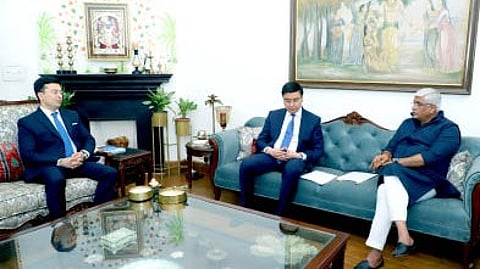Rediscovering the Silk Route
India and Uzbekistan have identified priority areas to promote tourism on tourist routes along the Silk Route and sites associated with Buddhism, which would attract travellers interested in the historical and cultural heritage of both countries.
“Pleased to meet Uzbekistan’s Minister of Tourism Umid Shadiev and Ambassador of Uzbekistan to India Sardor Rustambaev at my office. Looking forward to strengthening tourism ties between our nations,” said Gajendra Singh Shekhawat, Union Minister of Culture and Tourism.
In 2024, about 80,000 Indian tourists visited Uzbekistan, and this number is expected to increase exponentially, considering Uzbekistan’s free-visa initiative for Indians. “Indian tourists are drawn to our monuments including the grand Timurid mosques and mausolea which are the architectural ancestors of Humayun’s Tomb here in Delhi, and of the Taj Mahal in Agra,” said Umid Shadiev.
Meanwhile, Indian filmmakers too are being invited to shoot Bollywood movies in Uzbekistan. In January this year a meeting was held between noted Indian film maker Boney Kapoor and Ambassador Rustambaev.
Historic ties
India and Uzbekistan have historic relationship. India was one of the first countries to recognise the state sovereignty of Uzbekistan after the latter’s independence. The protocol on establishment of diplomatic relations between India and Uzbekistan was signed in Tashkent on 18 March 1992. The two nations declared their Strategic Partnership in 2011. Several institutionalised dialogue mechanisms operate at both political and official levels under this partnership, to ensure regular interaction and follow-up on cooperation activities.
India is amongst the top 10 trade partners of Uzbekistan, with bilateral trade amounting to $756.60 million. In 2022, India’s exports to Uzbekistan reached $512 million. These exports were primarily packaged medicaments ($220 million), raw sugar ($34.7 million), and vaccines, blood, antisera, toxins, and cultures ($18.9 million).
Box
Not just trade
Uzbekistan’s strategic position made it a melting pot of influences, and its cities thrived on this exchange
India’s connection to the Silk Route included several corridors, one of which extended to Uzbekistan. Uzbekistan was home to flourishing cities like Samarkand, Bukhara, and Termez, which served as critical nodes for trade and cultural exchange. These cities linked the overland routes from China and Central Asia to the Indian subcontinent, particularly through passes in the Himalayas and via trade networks in modern-day Afghanistan and Pakistan.
One key route from India ran through the Karakoram Pass and Western Himalayas, connecting cities like Srinagar and Leh to Central Asian trade hubs. Goods from India – such as spices, textiles, precious stones, and dyes – travelled north, often passing through Termez, a southern Uzbek city near the Amu Darya River, which acted as a gateway to Bactria and beyond. Archaeological evidence from Termez, like ivory figurines and glass fragments of Indian origin, points to trade ties dating back to the third-second centuries BC, even before the Silk Route’s peak.
Another branch, the southwestern route or ‘Tea Horse Road,’ stretched from India through the Himalayas to Tibet and eventually linked to Central Asian networks, including Uzbekistan. This route carried silk, saffron, and pashmina wool, among other items, fostering economic and cultural ties.
Uzbekistan’s strategic position made it a melting pot of influences, and its cities thrived on this exchange. Samarkand, for instance, was a cosmopolitan centre where Indian Buddhist ideas left their mark – stupas and monasteries unearthed there suggest monks and scholars travelled on these routes. Bukhara, a hub of theology and trade, likely saw Indian goods like cotton and gemstones in its bustling bazaars.
This wasn’t just about trade. The routes carried Buddhism from India to Central Asia, with Uzbekistan preserving relics of this influence in places like Termez’s Fayaztepa stupa. Conversely, Central Asian innovations – like advances in astronomy and mathematics from figures like Al-Biruni, who studied in India – flowed back southward.

